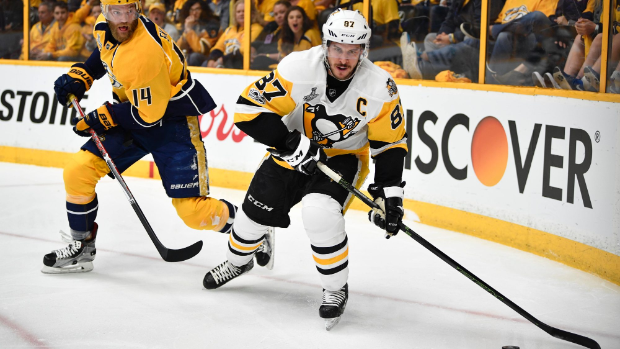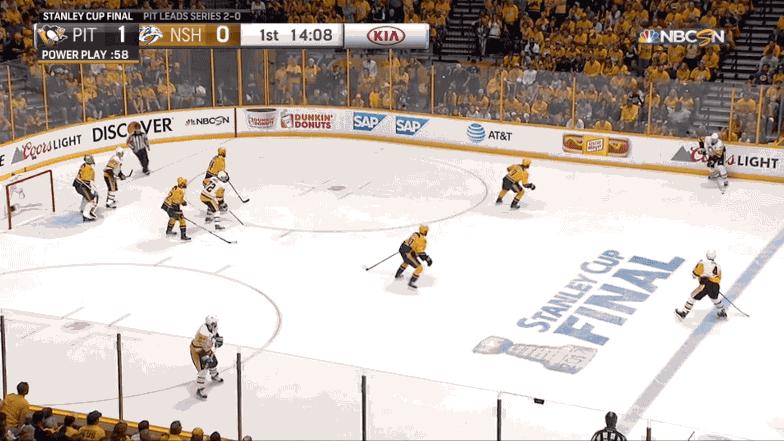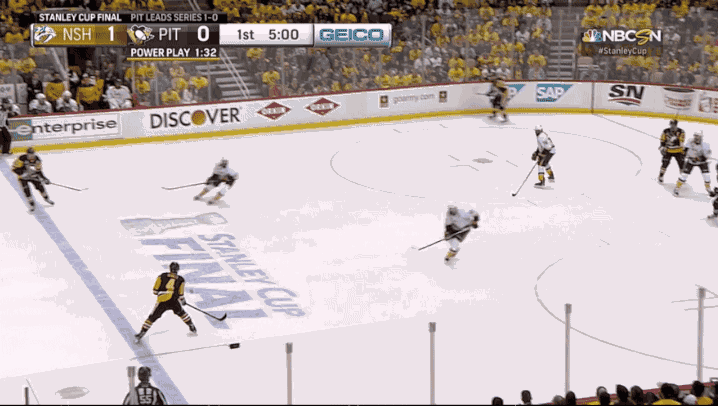Through the first three games of the Stanley Cup Final, the Penguins power-play has converted just one of their fifteen chances.
In game three, with a 1-0 lead in the early portion of the first period and a Nashville crowd that was bracing itself for potential disappointment, the Penguins had two man-advantage opportunities to blow the game open and take a firm hold on the game and the series as a whole.
Instead, the Penguins issues on the power-play gave momentum to the Predators.
To say the Penguins power-play has been maddening would be an understatement.
Nashville hasn’t reinvented the wheel with their structure. Even worse than that, their structure is one that the Penguins experienced first-hand against the Washington Capitals in the second round. That makes this struggle even more mind-boggling.
The approach for the Predators has been a simple one. When the puck goes low, the Predators collapse in box formation on goaltender Pekka Rinne. When the puck works to the point, the Predators forwards go on the hunt, putting pressure on the Penguins point-men. They’re not only there to block shots, they’re there to make players like Justin Schultz and Evgeni Malkin as uncomfortable as possible. If the players manning the point make one wrong move, the Predators could be off to the races.
The end result is a Predators penalty-kill that opens and closes like an accordion. When the puck goes low, the Predators collapse low. When the puck drives high, the Predators spread out. The East/West plays haven’t been there and the Penguins haven’t been able to establish any type of net front presence because 0f the Predators dedication to protecting the net front.
Although it might not seem like there’s a lot of space out there, the Predators are vulnerable in certain areas. The Penguins, however, aren’t going to find those areas if they continue to play stationary, spread out hockey. They’re operating on the power-play like a team that isn’t facing an opponent that is taking the slot away from them.
When the Predators spread out and attack the point, there’s space in the middle. When they collapse on Rinne, the points have room to move up. The Penguins, to date in this series, have taken advantage of neither of those opportunities.
Let’s take a look at the video.
There’s two things I want to focus on from the above clip.
To start, take a look at Patric Hornqvist settle into the slot as this play develops. Phil Kessel has a direct line to Hornqvist in the center of the ice and doesn’t take it. The Penguins haven’t been able to get a player in the slot with any type of regularity, and once they get one there, they don’t even use him.
The second, and most important, is what happens when this puck goes behind the net. Take a look at how the Predators collapse. A ton of space opens up at the top of the circle. This play working out from behind the net gives either Schultz or Malkin the perfect opportunity to activate and move up into this play. Neither takes that opportunity.
Remember what we established at the start of this breakdown. Nashville is going to collapse when the puck works down low. There’s an entire sheet of clean ice here, but no one takes initiative with it. Kessel stays on the perimeter. Malkin sneaks up slightly, but stays on the perimeter. Schultz stands at the top of the zone.
The only movement in this sequence once the puck gets behind the net is the movement of Crosby. Everyone else sticks to the perimeter.
Here’s another great look at this perimeter issue.
Look at how the Predators pressure spreads the Penguins out completely.
The puck is worked up to the point. The Predators attack immediately as they have all series. The Penguins walk themselves straight into no-man’s land, and the puck is immediately shot out of the zone.
There’s no release here for the Penguins defensemen. All throughout the series, the Penguins have seemed keen to try and run their power-play from the point instead of the half-wall. Here’s a great example of why that’s a bad idea.
Moreover, look at the area in the middle of the offensive zone. It’s parting wide open. There’s not a single white shirt in the middle of the ice here. The Penguins don’t even have a presence in front of Pekka Rinne. The Predators defense can spread how because they don’t have to commit resources to a net-front battle.
In the above clip, we can once again see how the Predators pressure is walking the Penguins to the perimeter of the ice.
There’s a disconnect here between whats happening at the top of the offensive zone and the bottom of the offensive zone. As this puck goes high and the Predators chase it, the forwards don’t attempt to work into a release area at all.
Once again, look at the open area of ice in the middle of the slot. Once this puck gets worked high, the Penguins have an ocean of space available to them with nobody taking advantage of it. Sidney Crosby doesn’t move at all in this clip. There’s no real sense of purpose here.
The Penguins are getting bullied by the Predators penalty-kill right now. There’s not enough movement, not enough puck-support, and a giant gap between the players on the point and the forwards down low.
If the Penguins can take advantage of the soft spot in the middle of the predators box, that’s a great first step to generating scoring chances. If they can shift the focus of the power-play from the half-wall or behind the net, they’ll be able to sneak players into the fold to generate shot opportunities.
Right now, the Penguins power-play is a game of high-pressure patty-cake on the point. If they want to convert these chances into goals, that mindset has to change.
Add The Sports Daily to your Google News Feed!



